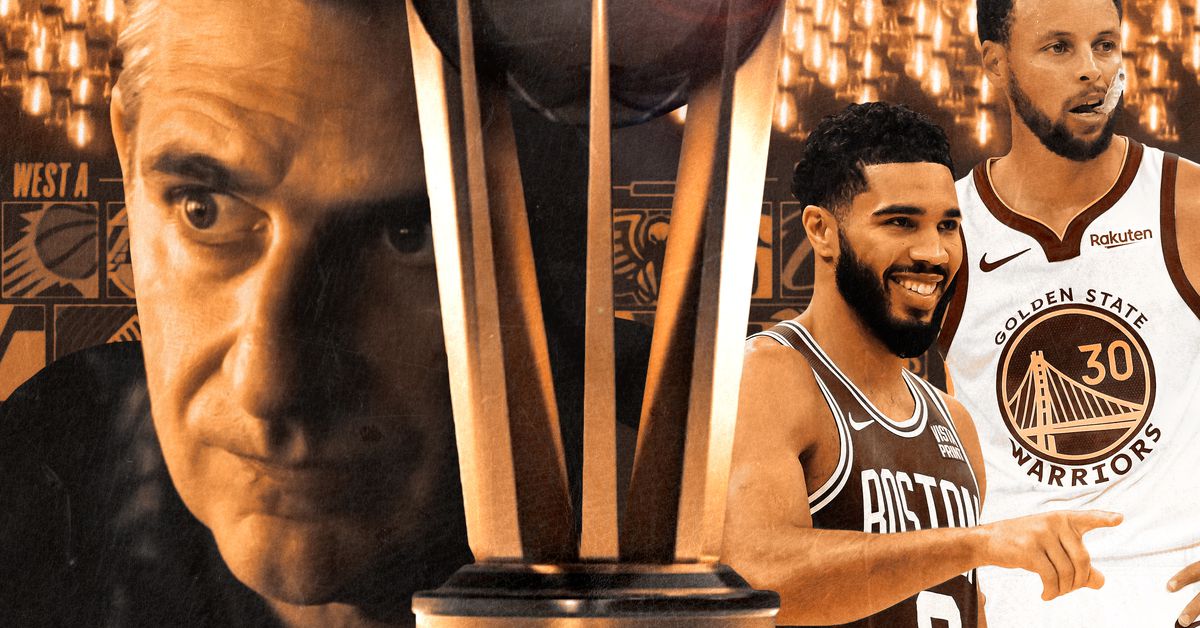Sports
The Ringer’s Guide to the NBA In-Season Tournament – The Ringer

Filed under:
How the hell is this thing going to work? Why is Michael Imperioli the face of it? And what can we expect from the games? We catch you up to speed and give you everything you need to know about the NBA’s inaugural midseason tourney.
There is something incredibly funny about the NBA tapping Michael Imperioli, the Sopranos-star-cum-Tibetan-Buddhist, to narrate and appear in “The Heist,” a stylish Ocean’s Eleven–themed montage used as a promo for the league’s inaugural in-season tournament. The monthlong event begins Friday and concludes with the NBA Cup championship game on December 9 at the T-Mobile Arena in Las Vegas. The casino imagery in the commercial is laid on thick, and who better to extol the grandeur of Sin City than a man who has taken the bodhisattva vow—and has also provided voice-over narration for Whistleblower, a 10-part investigative podcast about the Tim Donaghy betting scandal?
In another era, perhaps the mysterious gambler image that Imperioli evokes in “The Heist” would have cut too close to home. But the NBA revels in its self-awareness these days—Draymond Green is “a vet who isn’t afraid to get his hands dirty”; Kawhi Leonard is the “inside man who is everywhere and nowhere.” It has nothing to hide, and everything to gain.
“To really practice Buddhism, in my point of view, it really requires real honesty with yourself,” Imperoli recently said on a podcast for Tricycle: The Buddhist Review. Perhaps through the prism of Imperioli’s slick, typecast presence, the NBA is being honest with itself. It’s not the players pulling the heist; it’s the league.
With the festivities all set to begin, let’s answer some pressing questions about the tournament.
I don’t know.
Sorry, that was reflexive—“I don’t know” is an incredibly efficient conversation ender that, for a weasel like me, feels undervalued in modern dialectics, especially for topics that absolutely do not matter. I kind of wanted to try it out in an FAQ, just to see what it’d feel like. And I was hoping you would fall for it.
The NBA, Ranked
Click here to read the The Ringer’s 2023-24 NBA rankings.
But, fine. For you, dear reader, we will trudge forward. I do know why the in-season tournament is happening … I think. The NBA’s current media rights deal will expire at the end of the 2024-25 season, which puts the league in position to set a new standard for national sports broadcasting with the upcoming negotiations in 2024. There will be a 45-day exclusive negotiation period with the league’s current broadcasting partners, ESPN-ABC and Turner, beginning March 9; after that, in late April, the NBA will be allowed to have formal discussions with other interested parties, such as Amazon and NBC. Former ESPN executive John Skipper said earlier this year that he believes the NBA could see as much as a 350 percent increase in revenue compared to the previous media rights deal, which would mean a spike from an average of $2.7 billion annually to a ballpark of $8-9 billion.
With that much money on the line, and with the undeniable shift in consumption habits in the age of mainstream streaming services, the NBA is looking to diversify its media packages and diverge from the Disney-Turner dichotomy for the first time in decades. And in the final two seasons before the current deal elapses, the NBA has introduced an artificial solution in hopes of preempting a question that will invariably come up in negotiations, something of a cultural platitude in American sports discourse: No one cares about the NBA until Christmas.
The in-season tournament, then, presents a neat and tidy capsule of games from early November to early December to disprove that notion—or at least try to chip away at it.
And if things go as planned, the exclusive broadcast rights will be sold to the highest bidder.
If you’re more of a visual learner, here is Richard Jefferson explaining how it all works:
(If you’re not, then please bear with me as I assume the role of a parent who has just spent all night trying to relearn how the quadratic formula works just to make sure their child won’t flunk algebra the way they did.)
The in-season tournament features a group stage and the knockout rounds. In group play, all 30 NBA teams are split into six pools of five within their conferences—three pools in each conference—randomly assigned based on their record in the previous season. Group play consists of four games played against pool mates between now and November 28, with each team playing two home games and two away games.
The pools are as follows:
The six teams with the best record within their respective pools, along with two wild cards (the second-place teams with the best winning percentage in group play), advance to the knockout round. Tiebreakers for the two wild-card spots will be determined first by the group stage head-to-head records among the wild-card hopefuls in question, then by point differential, then by total points scored in the tournament, then by regular-season record in 2022-23, and finally by a random drawing, should we enter the Twilight Zone.
From there, the eight teams that advance play in a single-elimination quarterfinal round held on December 4 and 5, with the higher seed hosting the game at their usual home arena. The semifinals and championship game will be held at a neutral location—T-Mobile Arena in Las Vegas.
Related
Every game played in the in-season tournament,* including the quarterfinal and semifinal clashes, will also count as part of each team’s 82-game regular season. As you may have noticed in the regular-season schedule, your favorite team has only 80 games locked in. The two games that bring each team up to 82 total will be either in the quarterfinal and semifinal games, or in games that are scheduled during the tournament to fill the voids. If that doesn’t make sense to you, just know that it really doesn’t matter to the viewer at all. You’re getting 82 games from a team one way or another. Eighty-three if you’re lucky!
(*Except for the championship game, which exists in a vacuum. Kinda takes the whatever happens in Vegas stays in Vegas conceit a bit too literally, but who am I to stand in the way of a multibillion-dollar get-rich scheme?)
Oh, you’ll know. Each game will be seared into your corneas with the magic of custom-painted hardwood courts exclusive to in-season tournament games.
I don’t know—sorry, I did it again. Yeah. It’s a lot.
Thank you for asking!
There is something about New Orleans’s court that really sings to me, as someone whose passion is also graphic design: the classic MS Paint color scheme of Dimetapp Purple and Nuclear Radiation Green working in haunted harmony; the Pelicans logo, which was absolutely mangled by the magic wand tool in Photoshop and set to minus-100 lightness; the complete and utter disregard for the viewer’s experience.
I’m also a big fan of San Antonio’s court. It’s a very pleasing color scheme—almost makes me want to partner with a mezcalera and open a modern cantina in a suburb. Dare I say, it’s artfully done.
“It’s like art,” John Prater, the owner of a flooring company that painted more than a third of the NBA Cup court designs, said to ESPN’s Zach Lowe. “Some people like it, some people don’t. You can’t please everyone.” Very Imperioli of him.
Each player on the championship team will be awarded $500,000. Each player on the second-place team earns $200,000. Players on the two losing semifinalists will be given $100,000. Quarterfinalists get $50,000 each.
These figures are not concrete; they will increase each season, commensurate with the growth in the league’s year-over-year basketball-related income.
What do you mean, that’s it?
Nope, at least not in this inaugural iteration. Evan Wasch, the NBA’s executive vice president of basketball strategy and analytics, told The Athletic in July that the league had considered other incentives, including guaranteed postseason berths, draft picks, or cap exceptions for winners. Given how often the NBA tinkers with formats, these incentives probably aren’t completely off the table in the future.
The idea of an automatic playoff berth is an interesting one. It’s not a one-to-one comparison, but when I talked to Paul Franklin, the executive producer of MasterChef Australia—the greatest food competition show in the world—he mentioned a wrinkle that they had in the show’s very first season (and subsequently got rid of). One of the major incentives introduced was a golden pin that contestants could win early in the competition that would send them straight to the final, “which seemed like a good idea at the time,” Franklin told me. “But when we did that, when we brought them back to Finals Week, they hadn’t been in the kitchen for three or four weeks. So they’d come back in and they weren’t match fit anymore. And they’d come back in the kitchen and everyone else, they’ve got their eyes set on doing this. They’re match fit because they’ve just been cooking and living and breathing it.”
Of course, unlike in MasterChef Australia, winning a guaranteed playoff berth would not mean skipping out on the rest of the regular-season competition—at least not literally. The NBA Cup winner would still need to play out its schedule. How would that alter the dynamics of play? Would a newfound scarcity in available postseason seeds drive more competition for what is available? Would the winner opt to sleepwalk through the regular season, given the lack of incentive to press its stars for wins? For a league that already has to prove its players want to play in games, is that hypothetical even worth entertaining for a one-month flurry of artificially heightened competition?
That’s fair. At this point, I’m not sure it’s aimed to. If fans see this as just an overproduced weekly series of regular-season games, it’s because that’s exactly what the in-season tournament is. The tournament is a proof of concept for both the league and its potential broadcasting suitors, and it relies on the players on the court to be compelling.
Cash is a powerful motivator. The eight- and nine-figure deals that paint the modern landscape of the league may have desensitized us all, but $500,000 is a lot of money for anyone. And the money doesn’t go just to the stars; it also goes to the players who sit at the end of the bench, for whom an additional $500,000 would be a godsend. For instance, the winner’s prize is roughly the value of an NBA two-way contract salary for the 2023-24 season ($560,000). An entire year’s salary for a two-way player can be made in the span of a month. That’s a prize worth busting ass for, and a goal that players can easily rally around.
Philadelphia 76ers versus Golden State Warriors.
I don’t know.
Check your inbox for a welcome email.
Oops. Something went wrong. Please enter a valid email and try again.
Check your inbox for a welcome email.
Oops. Something went wrong. Please enter a valid email and try again.
Jess, Jomi, and Steve tackle the last two episodes and what we can expect in Season 2
Rachel, Chelsea, and Jodi discuss the best celebrity interactions, the most interesting panels, and more from the first day
Plus, Mal and Jo dive into the Season 2 premiere of ‘Invincible’
In “Science/Fiction,” the penultimate episode of the second season, Loki levels up and levels with Sylvie—and himself
Rosenberg and Dip also discuss the big differences between AEW and WWE
Plus, Ceruti and Kyle join to make this week’s Alliance Parlay before closing the show with some listener-submitted Life Advice questions
An SB Nation affiliate site









